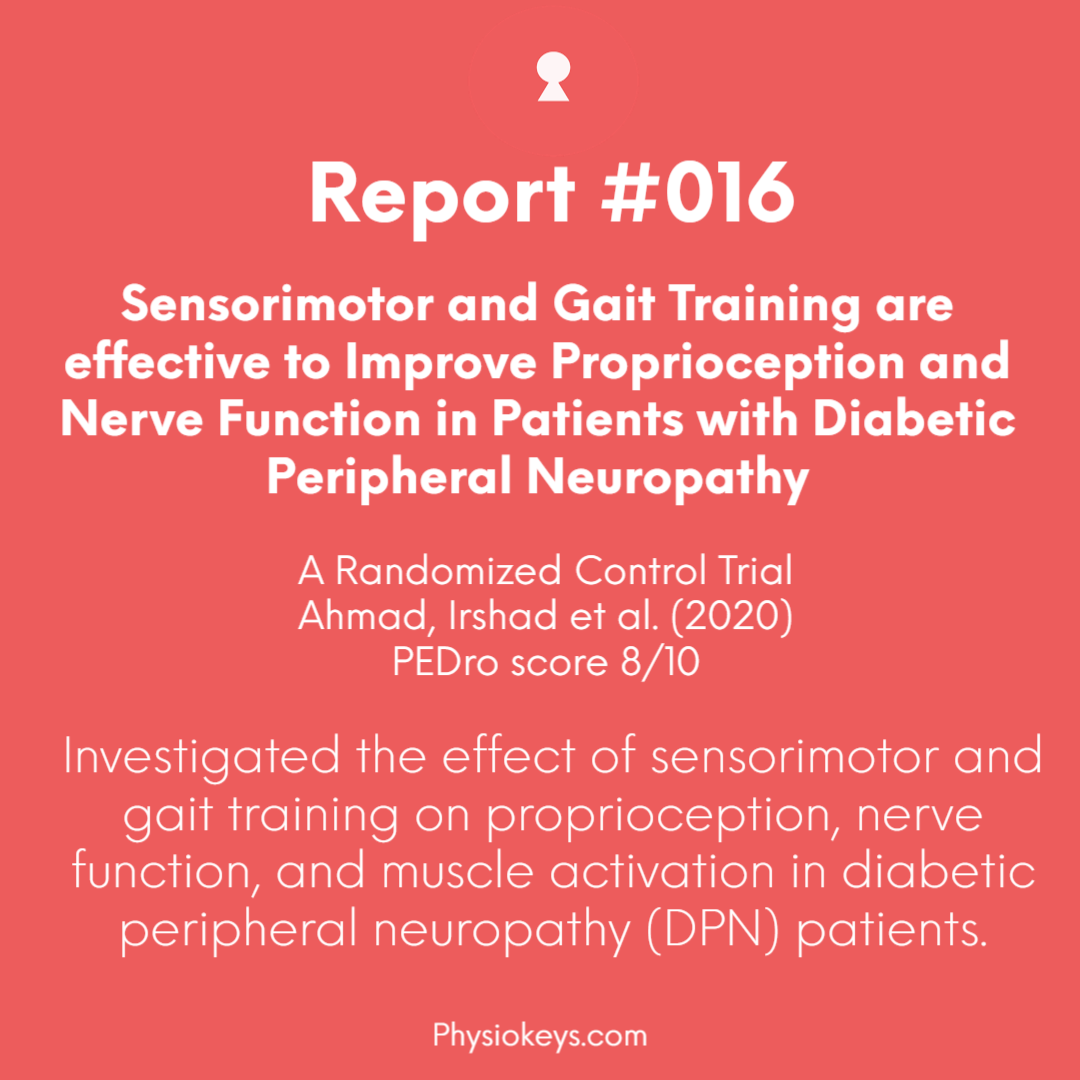#016-Interventions for Diabetic Peripheral Neuropathy
Estimated reading time: 2 minutes, 20 seconds.*
Sensorimotor and Gait Training are effective to Improve Proprioception and Nerve Function in Patients with Diabetic Peripheral Neuropathy
Diabetic Peripheral Neuropathy (DPN) is the most common diabetic neuropathy associated with diabetes mellitus, affecting sensory and motor peripheral nerves, it can be divided to 2 types:
- Acute sensory neuropathy.
- Chronic sensorimotor neuropathy.
Peripheral neuropathy is s associated with greater proprioception thresholds, decrease in the compound motor nerve amplitude, lower conduction velocity and increase in latency.
This RCT (PEDro score 8/10) investigated the effect of sensorimotor and gait training on proprioception, nerve function, and muscle activation in diabetic peripheral neuropathy (DPN) patients.
2 Groups, the intervention group (21 Participant) received sensorimotor and gait training with diabetes and foot care education. Control group (17 Participant) received only diabetes and foot care education.
Interventions:
- Sensorimotor and gait training: (Complete description of the program here)
- 10 Minutes of warm up; cycle ergometer or treadmill at intensity of 40-50% maximal heart rate.
- 50 to 60 Minutes of Sensorimotor and gait training; wall slides, bridging exercises, prone plank, sit to stand, wobble board exercises, one leg stance, heel and toe raise, tandem stance gradually progressed to different grades using unstable surface and gait training (different patterns of walking).
- 5 to 10 Minutes of cool down; deep breathing, abdominal breathing and mild stretching.
- Total does: 65 to 80 minutes/session, 3 sessions/week for 8 weeks.
- Exercise was progressed every 2 weeks unless the participant was not able to perform the next level.
- Diabetes and foot care education:
- Material to understand diabetes, diabetes management and foot care guidelines.
- Once every two weeks for 30 minutes.
Results:
- Proprioception: intervention group significantly improve proprioception in front, back, left and right directions. Measured by using Pedalo-Sensamove Balance Test Pro with Miniboard.
- Nerve conduction studies:
- Conduction velocity of the peroneal nerve showed a 6.43% increase in the intervention group whereas control group showed an increase of 0.6% only.
- Latency, amplitude and duration of the peroneal nerve were found to be non-significant
- Conduction velocity for the tibial nerve increased in both groups, 2.46% in the intervention group and 8.83% in the control group.
- The intervention group showed decrease in the distal latency of tibial nerve by 8.54%, while the control group showed increase in the latency by 6.97%.
- No significant difference in the amplitude and duration of the tibial nerve.
- Electromyographic activity:
- Reduction in the activity of tibialis anterior, medial gastrocnemius and multifidus during eyes open and
- Decrease in the activity of tibialis anterior, medial gastrocnemius and multifidus during eyes closed stance on an unstable platform.
- Indicating enhanced postural control at the level of ankle and trunk after intervention.
- Adverse events: one patient complained about aggravated pain in the leg during a set of exercise intervention and another patient had hypoglycemia in only a single session.
Learned from this study:
- Sensorimotor training and gait training can improve proprioception, nerve function and activity of the lower limb musculature for patients with peripheral diabetic neuropathy.
Note:
- Participants in this study had mild to moderate level of neuropathy.
- The sample size of the study was small.
Recommended reads:
Reference
*Calculation is based on the average reading speed that around 200 words per minute (wpm)


